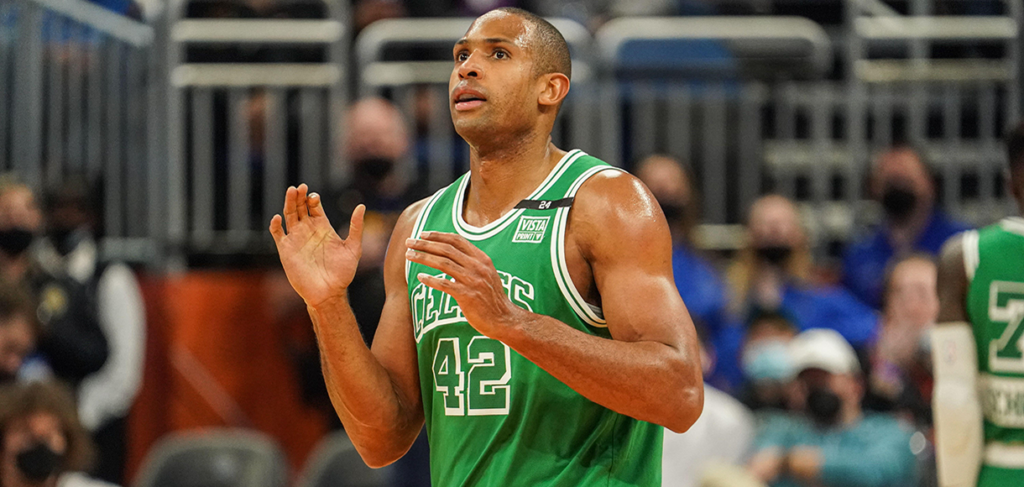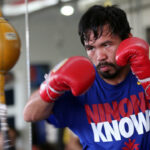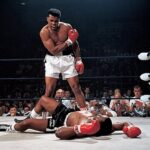In basketball, passing is one of the most underappreciated skills since, historically, players have been more concerned with scoring points than with passing the ball to teammates. The purpose of this list is to honour the greatest passes in NBA history who have never received the credit they merit. Great passers like Magic Johnson and Steve Nash are well known to us, but there have also been hidden heroes like Andre Miller who never receive the credit they deserve. See which NBA players are now playing as well as the players from the past that you tend to forget about making the list.
Top 10 Best NBA Basketball Passers In History
1. Magic Johnson
In NBA history, Magic Johnson is the best passer. He was a trailblazer, the first player to handle and make plays in that manner at his large 6’9″ stature. As soon as he took the court, he outmatched his opponent in terms of size, strength, and frequently even speed. Magic had incredible rip-and-run speed and posed a serious danger thanks to his combination of court vision and downward pressure. Johnson’s game consisted mostly on going coast to coast. With a lifetime average of 7.2 boards each game, he might rebound like a big forward. Magic would then use his deceitful play style to manipulate the defences of his opponents. His objective was crystal clear: penetrate the defence, get a paint touch, and then find an open comrade.
Magic’s justification for this top spot is strengthened by the numbers. Despite having only played 907 career regular season games, he is a member of the elite 10,000 dimes club. Each of the other group members had played more than 1,200 games. The first ballot Hall of Famer, one of the greatest Lakers to ever put on a uniform, led the league in assists four times and took home five rings.
2. John Stockton
Based on statistical data, the veteran Jazz player holds the top spot for most assists in NBA history. His size is the single uncontrollable factor keeping him from moving up to the number one slot on this list. In fact, his 6’1″, 170 lb. frame made it even more amazing that he accomplished the accomplishments he did during a time when basketball was a rough, violent game. Karl Malone was Stockton’s on-court partner, and this relationship must be considered in any analysis of his facilitation. Their pick-and-roll match was entertaining to watch as well as successful. In each and every one of Stockton’s seasons there, the Utah Jazz made it to the post-season thanks to that incredible little-big combo. Jordan and the Bulls ultimately proved to be too much for the Jazz, as they would for many other great teams of the late 1980s and early 1990s. As a floor general, John was capable of doing everything.
On the court, John embodies the epitome of an iron man. Throughout his 19-year Utah Jazz career, the Hall of Fame lead guard hardly ever missed a game. In an astonishing 16 of these 19 seasons, he played in every one of the 82 games. Stockton, a ten-time All-Star, leads all players in assists ever with his combination of consistency and game-to-game production. At the summit of the mountain, John is by himself with 15,806 assists.
3. LeBron James
LeBron has incredible passing ability. Acknowledging that he is 6’9″ and has played small forward most of his career makes his playmaking toolset even more impressive. Maybe the greatest drive-and-kick player of all time is him. Over the years, James’ ability to penetrate defences and release the ball to shooters has resulted in hundreds of those crucial clean catch-and-shoot opportunities. LeBron has a remarkable talent for precisely identifying each player’s skills. This helps determine who should receive the ball based on the people in his immediate vicinity. LeBron’s speed and ability to guide a teammate into the shot are two more components of his playmaking arsenal that contribute to his dominance.
Having these bullet passes at his disposal, he can easily zip them through small passing windows. In every NBA season since he entered the league, the product of Akron, Ohio, has placed among the top-15 in terms of total assists. For the first time in his remarkable career, LeBron James led the league in assists in Year 17. James’s achievements on the court are well-known, but everything else he does at a high calibre sometimes overshadows his amazing invention for others.
4. Steve Nash
Craftiness, a basketball IQ that was unsurpassed, a relentless work ethic, and, of course, court vision were the main reasons why the Canadian point guard had success. At 6’3″, 195 pounds, Nash was too big to rely solely on his physical attributes to be a passer. He had to become proficient in angles, different pass delivery methods, playmaking ambidexterity, and speed adjustments instead. He was able to set up teammates by travelling to the necessary locations with his good speed and tight handle. His offence of seven seconds or less was the impetus behind the Suns’ well-known style. Nash’s ease as an effective playwright allowed for this fast-paced pace. Though it starts with Nash, Phoenix’s management and coaching staff have faith in their team to perform this way.
In these quick-hitter setups, his outlet passing was a weapon, and he especially developed lovely synergy with Amar’e Stoudemire. He might also be the greatest bounce passer to have ever stepped onto the floor. He became an exceptional player because of Steve’s passing. Although he became a superb shooter as well, very few MVPs in NBA history were even remotely as good at creating plays as he was. Nash was named the MVP of both the 2004–2005 and 2005–2006 seasons. Sadly, he was never able to secure a breakthrough victory in the Finals.
5. Jason Kidd
J-Kidd was possibly the greatest manipulator in history. That is to say, he was almost unmatched in his ability to deflect defenders’ attention just by looking at them. The 205-pound, 6’4″ Jason, more than anyone, employed lookaways, ball trickery, and head fakes. The fact that he was able to retain his abilities at high speeds set him apart from the group. Jason was a prolific open-court passer who was the catalyst for many memorable transition plays.
During his time with the Mavericks, Suns, Nets, and, to a lesser extent, the Knicks, he was the offensive motor. Kidd was a five-time assist champion and received ten All Star selections during the same period. Because of his playmaking abilities and durability over the long term, he is ranked second all-time in assists. Jason is only behind John Stockton, but even so, his 12,091 dimes are impressive. Jason made two trips to the NBA Finals while he was with the New Jersey Nets, but in his 17th NBA season (with the Dallas Mavericks), he finally took home a ring.
6. Larry Bird
Many people consider Larry Bird to be among the greatest NBA players of all time. A significant component of his historically successful strategy was his playmaking. His best passing lanes were straight off the catch and out of the post. His size allowed him to see above others and aim darts precisely where they needed to go. He was a major component—possibly the most significant—of Boston’s all-time offence. Larry was different from most superstars in that he was selfless. The main source of value for heavy-load-bearing scorers, especially in those days, was making baskets with the ball. Bird was a master at it as well, but he added amazing off-ball passing to it. He was intuitively aware of the court, a kind of sixth sense.
With his incredible touch passes and lightning-fast decision-making, Larry was a frequent leaderboard participant. More precisely, eight of his thirteen seasons saw him finish in the top-20 in terms of total assists. When it came to utilising the defensive focus that his scoring demanded and letting teammates capitalise on it, Bird was a trailblazer.
7. Tim Hardaway
Tim Hardaway will always be known for his sneaky crossover, which caused numerous ankle breaks throughout the NBA. Hardaway’s contributions as a passer who set up teammates are not nearly as well remembered. During his six seasons with the Golden State Warriors, Hardaway averaged 9.3 assists per game to start his career. After that, Hardaway played for the Miami Heat for six years, averaging 7.8 assists per contest.
8. Isiah Thomas
One of the greatest performers in the 1980s and the early 1990s was Isiah Thomas. As one of the best offensive coordinators in the NBA, he guided the Detroit Pistons “Bad Boys” to two championships. With the ball, Thomas never showed selfishness because he shared it with all of his teammates. Thomas wasn’t the tallest point guard at 6’1″, but he made good use of his height by being able to pass opponents with ease. If Thomas didn’t make a spectacular layup or jump shot, he would make some incredible passes. He enjoyed passing other cars in the lane and passing his colleagues money. In addition to winning an NBA championship, Thomas received other honours while he was a player. He was the two-time MVP in 1984–85, the assists leader with 13.9 PPG, and a five-time member of the All-NBA squad. He had a career-high 25 assists in that 84/85.
9. Oscar Robertson
Oscar “Big O” Robertson was a renowned NBA player who was arguably the league’s best passer at the time. As one of the first large guards, he was an elite playmaker who served as an inspiration to many modern-day basketball players. Robertson, who stood 6′ 5″, had excellent court vision that allowed him to spot passable opportunities. Additionally, he consistently outran defences with his superb ball handling abilities before dishing out a pass to his team’s big players.
Being the first NBA player to average a triple-double in a single season and an NBA champion with the Milwaukee Bucks in 1971, Robertson was undoubtedly a talented player. He also led the basketball league in assists six times. In the top basketball league in the world for 14 seasons, Oscar averaged a remarkable 25.7 points per game, 9.5 assists, and 7.5 rebounds. Based on statistical analysis, Robertson is among the greatest all-around NBA basketball players of all time.
10. Andre Miller
Andre Miller was greatest at passing, and you don’t make it into your age-39 NBA season unless you are outstanding at something. Although he continued to play in the basketball league as a backup point guard, Miller’s career averages were harmed, as he ultimately averaged 6.5 assists per game. Miller’s finest season was 2001–02, when he averaged 10.9 assists per game, tops in the league.
More:
Most Watched Sports Around The World













